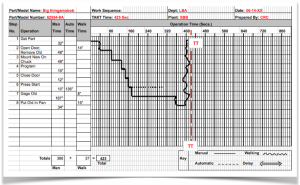My last post concluded a discussion of Takt Time. So, if you’re working to Takt Time, how do you know when each operation in your process is supposed to start and stop? How do you know if your operation is less than or equal to Takt Time? And, how do you communicate that to those in the process?
The answer to all those questions is to use a Standard Work Combination Sheet (SWCS). I know. That’s a mouthful, but it’s an extremely powerful tool that every Lean practitioner ought to have in their arsenal.
So what does it look like? Find one below*.
AUTHOR’S NOTE: I apologize that the image bleeds over into the “about the author” section of the page, but wanted to use as large a size as possible, as the clarity reduces to fit the post requirements.
This sheet is jam packed with actionable information. Let’s examine.
We can see that there are 8 operations to this process; can tell what each is called and how much of the time for that operation is spent doing manual (man) work, machine (auto) work and walking.
The bottom right gives us a key for the symbols used. There is no delay indicated in this SWCS, but we can tell how long each component of this operation takes; e.g. 32 seconds manual time and 14 seconds walking in operation #1. Finally we can see the total of manual and walk time spent performing this process.
From it, you can see the walking that takes place between operations 1 & 2, 7 & 8 and 8 back to 1. You can also tell in operation #6 that the machine continues to operate (horizontal dashed line) on its own and that the operator doesn’t stand watching. Rather, the operator moves to the next operation, #7 while the machine works away.
The vertical dashed red line is labelled TT, indicating that it’s the Takt Time for this process.
Now some questions for you:
- Can this process be completed in Takt Time (TT)?
- If you were going to improve this process, which operation would you try to improve first?
*NOTE: I made this form in Excel. Takes some patience, but then you can type in it. Of course, you can always whiteout an old one and make copies.
A1. Process takes 423 sec to complete. Takt Time is 425 sec; hence, the process can be completed in Takt time.
A2. The gaging process takes the longest and represents the greatest opportunity for improving the process time. Virtually every second of improvement would have an equal effect on improving the overall process time. Remember, the operator is actually working on the part from the previous machine cycle. Things you might consider doing are to automate the entire gaging process; or, use more automated tools. For example, you might use a vision system for gaging rather than a manual profilometer if the ROI is good.


